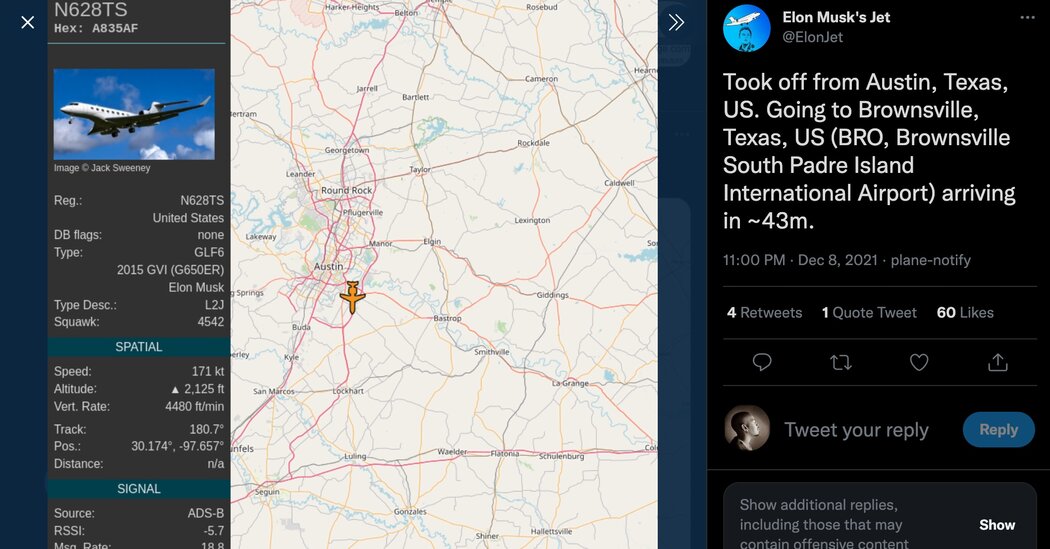Jack Sweeney, a freshman at the University of Central Florida, said that Mr. Musk raised privacy and security concerns about his popular Twitter account, @ElonJet.
For Elon Musk, the billionaire chief executive of Tesla and founder of SpaceX, traveling by private jet is not such a private endeavor.
Jack Sweeney, 19, a freshman at the University of Central Florida in Orlando, has been tracking a Gulfstream G650ER that he identified as Mr. Musk’s private jet and posting maps of its whereabouts on a popular Twitter account since June 2020.
Mr. Musk is not the only famous person being followed by the pesky wingman, who has thwarted efforts by Mr. Musk and others to cloak their movements on aircraft-tracking applications and websites.
The nosy can also keep up with Drake, Mark Cuban, Jeff Bezos and Bill Gates on Mr. Sweeney’s other accounts.
Mr. Sweeney said on Wednesday that he was able to track them using data from their plane’s transponders — a public record that includes the aircraft’s altitude, latitude and longitude and heading — an algorithm and a bot that he created.
But Mr. Musk was rather vexed by the flight-tracking gambit, Mr. Sweeney recalled in an interview, saying that he received a direct message on Nov. 30 from the billionaire on Twitter asking him to deactivate the account @ElonJet.
“I go like, Oh my gosh, Elon Musk just DM’d me: ‘Can you take this down? It’s a security risk,’” Mr. Sweeney said. “Then he offered me $5,000 to take it down and help him make it slightly harder for ‘crazy people to track me.’”
Mr. Sweeney provided screenshots of the exchange to The New York Times, which was not able to independently verify its authenticity.
Mr. Musk did not immediately respond to messages seeking comment on Wednesday, including to say whether he sent the messages.
The exchange highlighted the tension between open public records and privacy — and it was not the first time famous people had been tracked. Journalists have used flight-tracking apps to follow politicians ahead of vice-presidential selections. Investors use them to shadow chief executives to get wind of corporate mergers. Sports fans have used them to track coaching candidates of their favorite teams.
Mr. Cuban, the billionaire owner of the Dallas Mavericks, declined to comment on Wednesday. Representatives for Mr. Bezos, the Amazon founder; Mr. Gates, one of Microsoft’s founders; and Drake, the hip-hop mogul, did not immediately respond to requests for comment on Wednesday.
Ryan Calo, a law professor at the University of Washington whose focus is technology and its legal implications, said on Wednesday that the Federal Aviation Administration required planes to transmit location data to prevent collisions and to help find lost aircraft.
“What this teenager is taking advantage of is a lack of foresight on the part of the F.A.A. that this would become a privacy problem for some people,” Professor Calo said.
Reached for comment on Wednesday, the F.A.A. said that the situation was outside the agency’s scope of authority.
Professor Calo was amused that a teenager would hear directly from Mr. Musk.
“There almost couldn’t be a greater power asymmetry between Musk and this teenager,” Professor Calo said. “This is not David and Goliath. This is like Goliath and a flea on David.”
Mr. Sweeney said that he was drifting off to sleep when his Android phone buzzed at 12:19 a.m. on Nov. 30. He had been in his dorm room, where several posters promoting SpaceX, Mr. Musk’s space exploration company, were hanging on the wall above his bed, according to a photograph shared on Mr. Sweeney’s personal Twitter account.
Mr. Sweeney made a counteroffer to Mr. Musk, according to the screenshots of the exchange, saying that he would abandon the account if Mr. Musk upped the ante to $50,000. He said that he would also accept a Tesla Model 3, an electric car that costs more than $38,000, adding that he was joking.
In the exchange, Mr. Sweeney was asked how he had been able to track Mr. Musk. He explained that he had obtained the plane’s transponder data. When told that paying to have the Twitter account shut down didn’t seem right, Mr. Sweeney made another proposal: How about an internship?
The exchange, which carried on for more than a month, went silent after Jan. 23.
Mr. Sweeney downplayed the privacy and security concerns associated with his tracking account for Mr. Musk, which has more than 305,000 followers.
“It’s a private jet so he goes right from the jet to the car,” he said, adding that he has long been fascinated by tracking planes. “I don’t think it’s that big of a concern. Some people are just interested in seeing where he goes.”
Mr. Sweeney said that he obtained the data for his aircraft-tracking accounts from the ADS-B Exchange, which describes itself on its website as the world’s largest source of unfiltered flight data.
Dan Streufert, the founder of ADSBexchange.com L.L.C., said in an email on Wednesday that anyone with basic electronics could obtain the signals from aircraft that broadcast their locations. The information is also available by listening to air traffic controllers, he added.
“However, it is important to note our website tracks aircraft, not individuals,” Mr. Streufert said. “We cannot say who is or is not on the plane. Mr. Musk’s companies own and operate many aircraft — this is only one of them. Mr. Musk may find Mr. Sweeney’s activities annoying, similar to paparazzi, however, this information is already public from a myriad of sources.”
Professor Calo said that as long as Mr. Sweeney did not create the flight-tracking accounts to demand money from Mr. Musk and others, it would be difficult to make a criminal case that it was extortion.
“You’d have to purposely create this harm and hold it over somebody,” he said.
Professor Calo said that it would be difficult for a public figure like Mr. Musk to bring a civil lawsuit against Mr. Sweeney contending that his privacy had been breached.
“So I think there would be real hurdles to try to pursue this kid, civilly,” he said.
Still, he cautioned that Mr. Sweeney could open himself up to litigation if he took it too far.
“That’s quite a ride,” he said. “He just has to proceed carefully from here.”
After Mr. Sweeney’s last message to Mr. Musk on Jan. 23, the exchange bore a certain finality.
“You can no longer send messages to this person,” an automated message from Twitter read.












